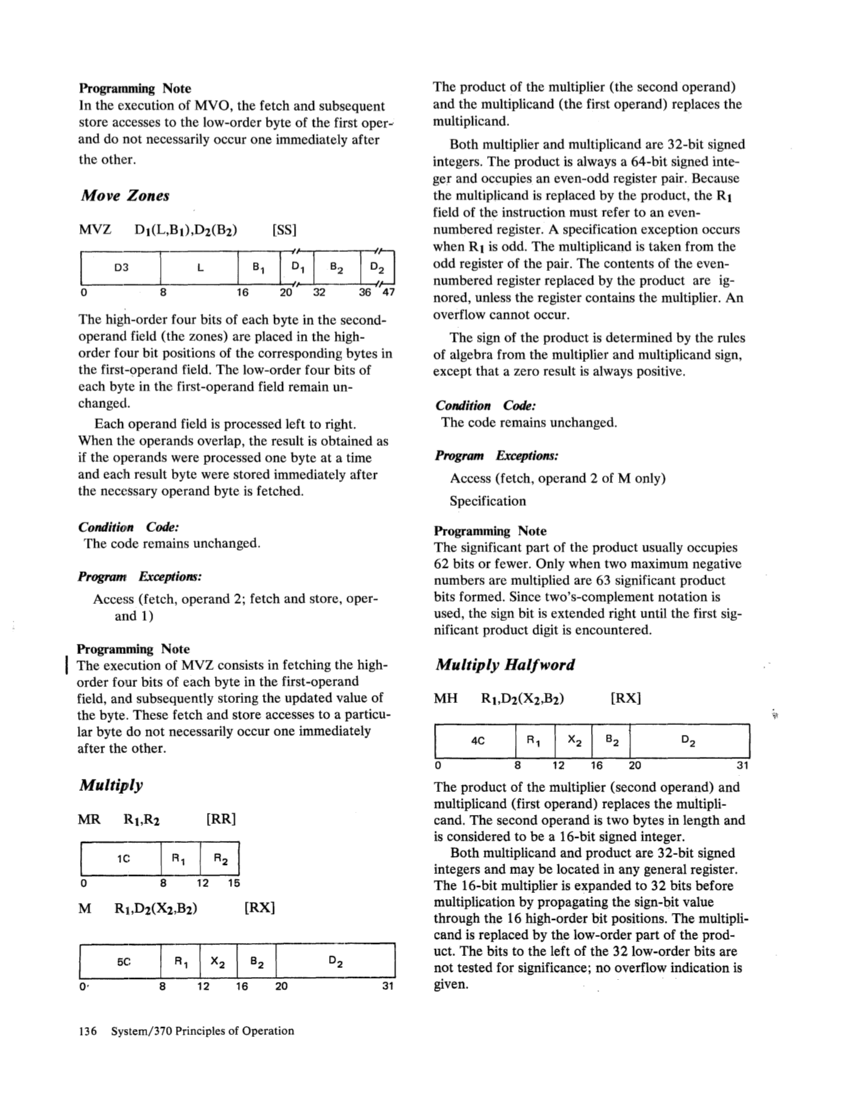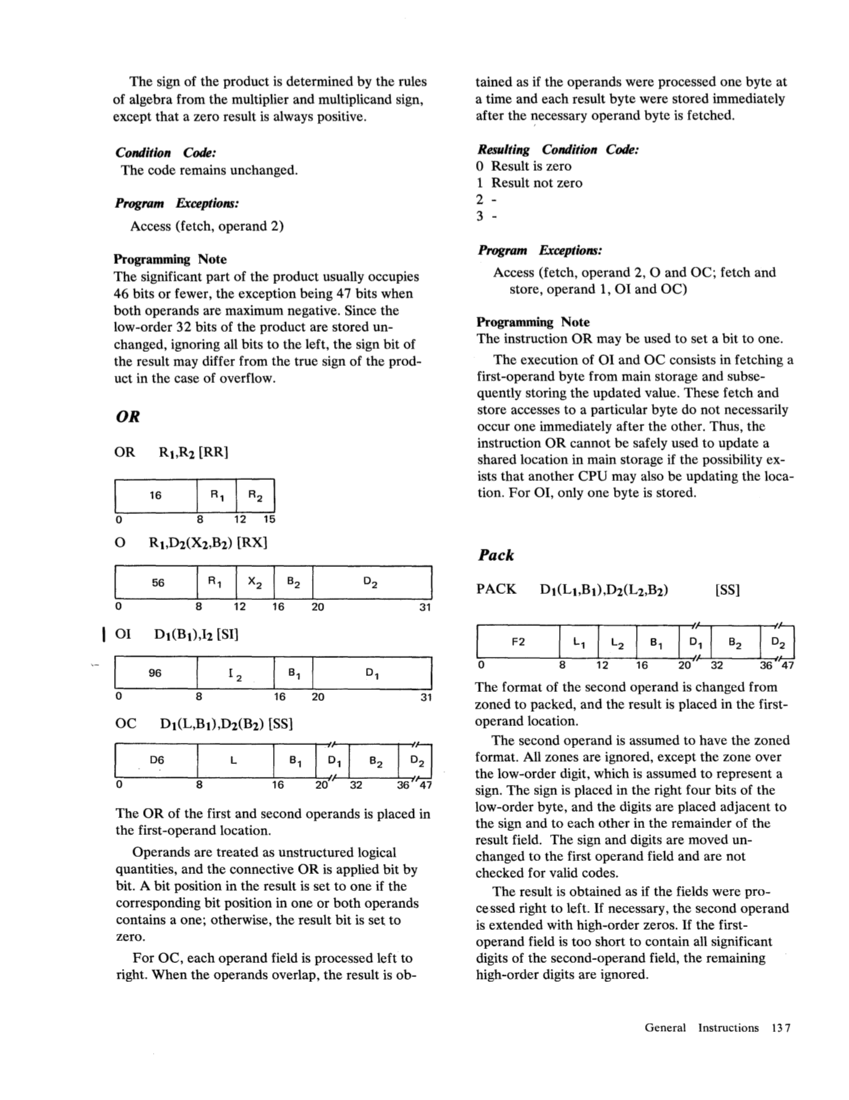Programming Note
In the execution ofMVO, the fetch and subsequent
storeaecesses to the low-order byte of the first oper-'
and do not necessarily occur one immediately after
the other.
Move ZonesB, 20 32 36 47
The high-order four bits of each byte in thesecond operand field (the zones) are placed in the high order four bit positions of the corresponding bytes in
the first-operand field. The low-order four bits of
each byte in the first-operand field remainun changed.
Each operand field is processed left to right.
When the operands overlap, the result is obtained as
if the operands were processed one byte at a time
and each result byte were stored immediately after
thenecessary operand byte is fetched. Condition Code:
The code remains unchanged.
Program Exceptions:
Access (fetch, operand 2; fetch and store,oper and 1)
Programming Note
The execution of MVZ consists in fetching thehigh order four bits of each byte in the first-operand
field, and subsequently storing the updated value of
the byte. These fetch and store accesses to aparticu lar byte do not necessarily occur one immediately
after the other.
MUltiply
MR Rl,R2 [RR]
136System/370 Principles of Operation The product of the multiplier (the second operand)
and the multiplicand (the first operand) replaces the
mUltiplicand.
Both mUltiplier and multiplicand are 32-bit signed
integers. The product is always a 64-bit signedinte ger and occupies an even-odd register pair. Because
the multiplicand is replaced by the product, the R 1
field of the instruction must refer to aneven numbered register. A specification exception occurs
when R
1 is odd. The multiplicand is taken from the
odd register of the pair. The contents of theeven numbered register replaced by the product are ig nored, unless the register contains the multiplier. An
overflow cannot occur.
The sign of the product is determined by the rules
of algebra from the multiplier and multiplicand sign,
except that a zero result is always positive.
Condition Code:
The code remains unchanged.
Program Exceptions:
Access (fetch, operand 2 of M only)
Specification
Programming Note
The significant part of the product usually occupies
62 bits or fewer.Only when two maximum negative
numbers are multiplied are 63 significant product
bits formed. Since two's-complement notation is
used, the sign bit is extended right until the firstsig nificant product digit is encountered.
Multiply Hal/word
MH Rl,D2(X2,B2) [RX]
4C
o 8 12 1620 31
The product of the multiplier (second operand) and
multiplicand (first operand) replaces themultipli cand. The second operand is two bytes in length and
is considered to be a 16-bit signed integer.
Both multiplicand and product are 32-bit signed
integers and may be located in any general register.
The 16-bit multiplier is expanded to 32 bits before
multiplication by propagating thesign-bit value
through the 16 high-order bit positions. The multipli
cand is replaced by the low-order part of the prod
uct. The bits to the left of the 32 low-order bits are
not tested for significance; no overflow indication is
given.
In the execution of
store
and do not necessarily occur one immediately after
the other.
Move Zones
The high-order four bits of each byte in the
the first-operand field. The low-order four bits of
each byte in the first-operand field remain
Each operand field is processed left to right.
When the operands overlap, the result is obtained as
if the operands were processed one byte at a time
and each result byte were stored immediately after
the
The code remains unchanged.
Program Exceptions:
Access (fetch, operand 2; fetch and store,
Programming Note
The execution of MVZ consists in fetching the
field, and subsequently storing the updated value of
the byte. These fetch and store accesses to a
after the other.
MUltiply
MR Rl,R2 [RR]
136
and the multiplicand (the first operand) replaces the
mUltiplicand.
Both mUltiplier and multiplicand are 32-bit signed
integers. The product is always a 64-bit signed
the multiplicand is replaced by the product, the R 1
field of the instruction must refer to an
when R
1 is odd. The multiplicand is taken from the
odd register of the pair. The contents of the
overflow cannot occur.
The sign of the product is determined by the rules
of algebra from the multiplier and multiplicand sign,
except that a zero result is always positive.
Condition Code:
The code remains unchanged.
Program Exceptions:
Access (fetch, operand 2 of M only)
Specification
Programming Note
The significant part of the product usually occupies
62 bits or fewer.
numbers are multiplied are 63 significant product
bits formed. Since two's-complement notation is
used, the sign bit is extended right until the first
Multiply Hal/word
MH Rl,D2(X2,B2) [RX]
4C
o 8 12 16
The product of the multiplier (second operand) and
multiplicand (first operand) replaces the
is considered to be a 16-bit signed integer.
Both multiplicand and product are 32-bit signed
integers and may be located in any general register.
The 16-bit multiplier is expanded to 32 bits before
multiplication by propagating the
through the 16 high-order bit positions. The multipli
cand is replaced by the low-order part of the prod
uct. The bits to the left of the 32 low-order bits are
not tested for significance; no overflow indication is
given.










































































































































































































































































































































